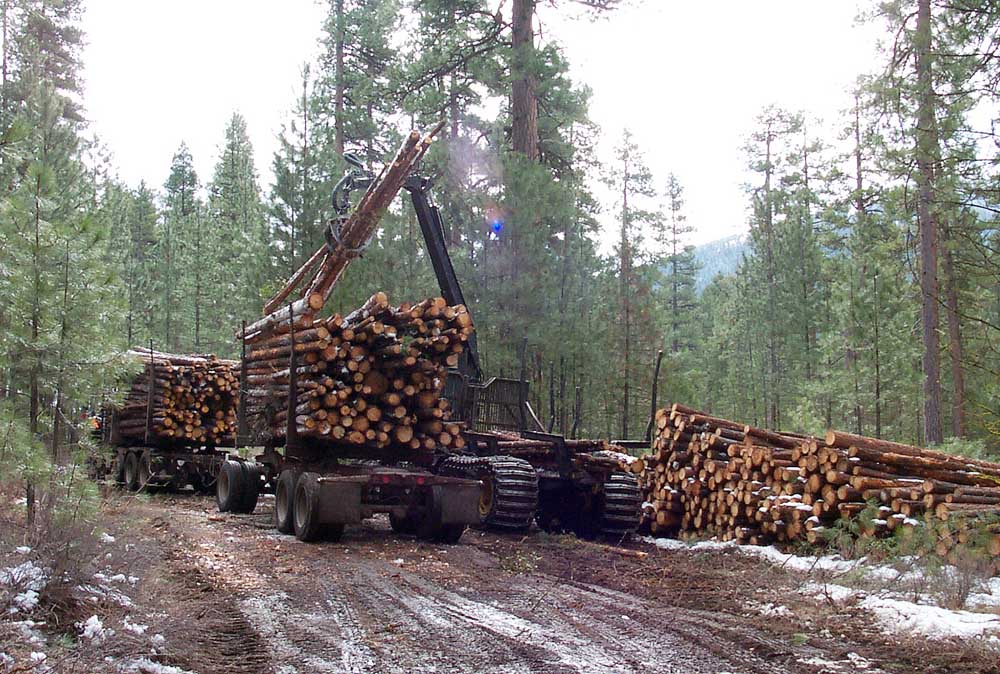Washington forest-thinning project upheld in federal court
Published 3:30 pm Monday, April 25, 2022

- Logs are loaded onto trucks after a thinning operation. A federal judge has rejected an environmental group's arguments against a national forest thinning project in Washington.
SEATTLE — A tree-thinning project within Washington’s Mt. Baker-Snoqualmie National Forest doesn’t unlawfully increase road miles or reduce cavity-nesting bird habitat, according to a federal judge.
U.S. District Judge David Estudillo in Seattle has rejected an environmental group’s arguments that the South Fork Stillaguamish Vegetation Project was approved in violation of the Northwest Forest Plan, affirming the findings of a magistrate judge.
In 2020, the North Cascades Conservation Council filed a complaint opposing the project, claiming the U.S. Forest Service “deceptively” characterized commercial logging as thinning while actually removing vegetation that’s environmentally beneficial.
“Defendants justify such drastic logging as ‘vegetation treatments’ by leaving isolated larger trees in place,” the complaint said. “Defendants propose to achieve ‘large tree forest structure’ by removing everything that is not a large tree, including vegetation which is a vital part of habitat for various species within the Mt. Baker-Snoqualmie National Forest.”
The Forest Service’s environmental analysis of the project determined that it would not have any significantly adverse impacts. The agency said thinning is necessary because high tree density and scarce understory are actually preventing forest stand structures that benefit wildlife.
“The goals of the stand treatments are to promote old forest characteristics with large diameter trees, stands with multiple layers of canopy, and the retention of down wood and snag components,” according to the Forest Service.
While the project’s boundary includes 65,000 acres of the national forest, the agency plans to commercially thin 2,000-3,300 acres and non-commercially thin about 1,000 acres.
U.S. Magistrate Judge Brian Tsuchida rejected the environmental plaintiff’s claim that the vegetation project violates the Northwest Forest Plan’s prohibition against increasing the net road mileage within national forests.
The Forest Service properly accounted for changes to roads within the project boundary and ensured temporary roads would be removed so there’s no net increase in road mileage, the judge said. Road mileage will actually decrease more than 18 miles by the time the project is done.
The environmental group claimed that road miles shouldn’t be increased even while thinning treatments are ongoing, since the project may take up to two decades to complete, but the court rejected this view.
“While Plaintiffs may interpret the ‘no net increase’ standard in a different manner, this does not render the Forest Service’s interpretation unreasonable,” Tsuchida said.
The Forest Service wasn’t required to focus solely on thinning trees that lacked commercial value in areas where road-building was unnecessary, the judge said.
“Plaintiffs assume that the beneficial goals of the Project can be fully achieved by applying thinning treatments only in areas where the timber is unmerchantable and therefore there is no need to utilize roads to remove felled timber from the landscape,” the ruling said. “However, nothing in the record supports this assumption.”
Likewise, the judge disagreed with the environmental plaintiff that the project wasn’t sufficiently protective of woodpecker habitat by providing enough snags for the birds to excavate.
The Forest Service’s analysis of the project’s effects on sensitive species was “not arbitrary and capricious” and it adequately examined the wildlife impacts under the National Environmental Policy Act, the ruling said.
It’s not up to the federal court to decide the project’s purpose or tell the agency how to best improve habitat in the forest, even if that means logging commercial-quality logs, the judge said.
“NEPA does not require the Forest Service to scale back its project in favor of an arguably more environmentally friendly alternative that plaintiffs would prefer,” he said.
The magistrate judge recommended dismissing the lawsuit, with which U.S. District Judge David Estudillo has now agreed and closed the case.
Timber sold from the project will help support a mill that employs 170 people owned by Hampton Lumber, which has intervened in the litigation to defend the project.
The project is also supported by the Darrington Collaborative, consisting of representatives of conservation groups, timber interests and local communities.
The collaborative sent a letter to the judge arguing the project strikes “a balance between several important values” in the national forest.
“Overall, we believe these treatments, over time, will increase the diversity, habitat value, and resilience of these stands and the landscape,” the collaborative said.






